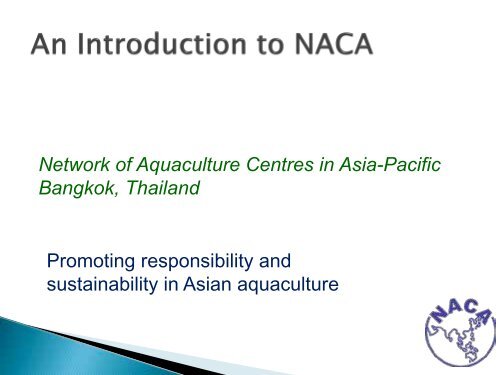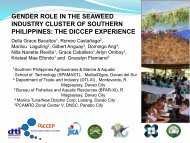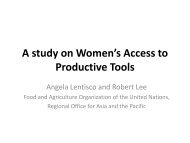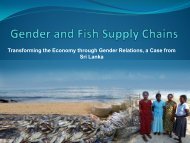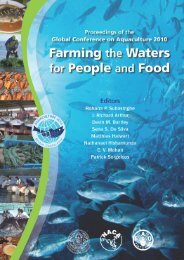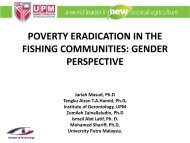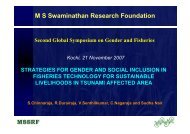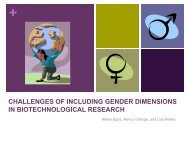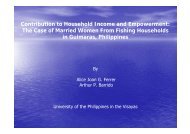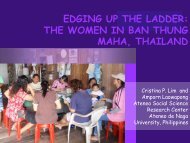Dr Ambekar E. Eknath - GENDER IN AQUACULTURE AND ...
Dr Ambekar E. Eknath - GENDER IN AQUACULTURE AND ...
Dr Ambekar E. Eknath - GENDER IN AQUACULTURE AND ...
Create successful ePaper yourself
Turn your PDF publications into a flip-book with our unique Google optimized e-Paper software.
Network of Aquaculture Centres in Asia-Pacific<br />
Bangkok, Thailand<br />
Promoting responsibility and<br />
sustainability in Asian aquaculture
• Established through international agreement in 1990<br />
• 18 member Governments in Asia Pacific<br />
Together produce >90% Global Aquaculture Production<br />
About 50% of global food fish supplies<br />
• Focus on sustainable regional Aquaculture Development<br />
through networking, sharing and communication<br />
• Completing 25 years on 31 st Dec 2014
Hong Kong<br />
18 NACA Member Countries<br />
• Australia<br />
• Bangladesh<br />
• Cambodia<br />
• China<br />
• Hong Kong SAR<br />
• India<br />
• Indonesia<br />
• IR Iran<br />
• Lao PDR<br />
• DPR Korea<br />
• Malaysia<br />
• Myanmar<br />
• Nepal<br />
• Pakistan<br />
• Philippines<br />
•Thailand<br />
• Sri Lanka<br />
•Vietnam
Governing Council (GC)<br />
◦ Meets annually and sets NACA policy<br />
◦ Representatives of the 18 member governments<br />
Technical Advisory Committee (TAC)<br />
◦ Develops the work programme and identifies<br />
priorities<br />
◦ Technical experts nominated by each member state<br />
Thematic Task Force<br />
◦ More than 90 experts<br />
Network of centres<br />
◦ Implements the work programme<br />
◦ 5 Regional Lead Centres and >30 participating centres<br />
in 18 states
Thematic Programs:<br />
• Sustainable Farming Systems<br />
• Genetics and Biodiversity<br />
• Aquatic Animal Health<br />
• Food Safety, Quality and Certification<br />
• Response to Climate Change<br />
Cross-Cutting Programs<br />
• Education and Training<br />
• Information and Communications<br />
• Gender<br />
www.enaca.org
What has been NACA’s role and involvement
Responsible development of Aquaculture<br />
Quality and food safety<br />
Animal health and welfare<br />
Integrity of the Environment<br />
Social responsibility<br />
Supporting livelihoods of small farmers
Translating principles to practice
A group of inter-dependent ponds situated in<br />
a specified geographical locality<br />
Cluster in Valsad, Gujarat<br />
Cluster in Tanjavur, TN<br />
Cluster in Kundapur, KA
Collective planning, decision making and<br />
implementation of crop activities
1. Good pond preparation<br />
2. Good quality seed selection<br />
3. Water quality management<br />
4. Feed management<br />
5. Health monitoring/Biosecurity<br />
6. Pond bottom monitoring<br />
7. Disease management<br />
8. Better Harvest and post-harvest<br />
Practices<br />
9. Record maintenance/Traceability<br />
10. Environmental awareness
2001<br />
Survey<br />
365<br />
ponds<br />
Risk<br />
factors<br />
BMPs<br />
India Case Study<br />
2002<br />
2002<br />
Farm<br />
level<br />
5 farmers<br />
10 ponds<br />
7 Ha<br />
4 tonnes<br />
2003<br />
Village<br />
level<br />
extension<br />
1 Village<br />
1 Aquaclub<br />
58 farmers<br />
108 ponds<br />
58 Ha<br />
22 tonnes<br />
Contract hatchery<br />
Seed Production<br />
2004<br />
Creek level<br />
extension<br />
6 Villages<br />
7 Aquaclubs<br />
130 farmers<br />
254 ponds<br />
173 Ha<br />
40 tonnes<br />
Expansion to<br />
other states<br />
AP<br />
GU<br />
KA<br />
2005<br />
State level<br />
expansion<br />
3 States<br />
19 Aquaclubs<br />
736 farmers<br />
1187 ponds<br />
663 Ha<br />
672 tonnes<br />
OR<br />
Expansion to<br />
5 states<br />
AP<br />
TN<br />
KA<br />
GU<br />
2006<br />
5 States<br />
28<br />
Aquaclubs<br />
730 farmers<br />
1370 ponds<br />
813 Ha<br />
870 t<br />
Establishment of<br />
NaCSA<br />
2007-08<br />
2007-08<br />
4 Coastal<br />
states<br />
153 Societies<br />
3326 farmers<br />
4219 ha<br />
2180 t<br />
Expansion of<br />
NaCSA<br />
2008-09<br />
2008-09<br />
4 Coastal states<br />
250 Societies<br />
6443 farmers<br />
7324 ha<br />
Market Linkage<br />
established<br />
2009-10<br />
2009-10<br />
5 Coastal states<br />
438 Societies<br />
10175 farmers<br />
4081 t<br />
10728 ha
BMPs and cluster model<br />
clearly demonstrated that it is<br />
possible to bring change in<br />
the behavior, attitude and<br />
practice of small farmers<br />
contributing to sustainability<br />
thinking
Who is driving and who is benefiting<br />
What is our role
Emergence of a wide range of certification<br />
schemes<br />
Cost/benefit value for producer still not clear<br />
Confusion in the minds of producers and<br />
consumers<br />
Need for improved harmonization of<br />
standards<br />
Need for benchmarking, mutual recognition<br />
and equivalence
Achieve economy of scale<br />
Reduce cost & efforts of certification<br />
Enable small scale farmer to<br />
participate
How to minimize the impact of trans-boundary<br />
aquatic animal diseases
Works closely with international,<br />
regional and national organizations:<br />
Improve regional cooperation to<br />
reduce risks of aquatic animal<br />
disease impacting on livelihoods<br />
of aquaculture farmers, national<br />
economies, trade and human<br />
health.<br />
www.enaca.org
21 Participating Countries<br />
Myanmar
Asia Regional Technical<br />
Guidelines (TG): Global Context.<br />
‣Consistent with FAO code of conduct for<br />
responsible fisheries<br />
‣OIE Aquatic Code and Aquatic Manual<br />
‣ICES protocols<br />
‣Adopted by 21 countries in Asia-Pacific<br />
‣Adopted by ASWGFi of the ASEAN<br />
‣Promoting implementation of TG is the<br />
main focus of NACA’s health program
Addressing Asian Concerns<br />
Asia Regional Advisory Group on Aquatic Animal Health (AG)<br />
AGM 7<br />
Composed of invited aquatic animal<br />
disease experts and representatives<br />
from World Organisation for Animal<br />
Health (OIE), Food and Agriculture<br />
Organization of the United Nations<br />
(FAO), collaborating regional<br />
organizations, and the private sector.<br />
AGM 9<br />
www.enaca.org<br />
AGM 10
“networking and sharing to<br />
manage”<br />
Quarterly Aquatic Animal<br />
Disease (QAAD) Reporting<br />
System: Asia-Pacific<br />
• First published in the 3 rd quarter of<br />
1998;<br />
• Includes all OIE-listed diseases plus<br />
diseases of regional importance;<br />
• Serves as early warning system for<br />
emerging diseases in the region;<br />
• Useful mechanism for recognizing<br />
emerging disease problems in the<br />
region, and guide to participating<br />
countries in revising their national list<br />
of reportable diseases.<br />
www.enaca.org
Supporting outbreak investigations in case<br />
of emerging diseases
Improving biosecurity to support<br />
sustainability<br />
Regional Expert Group Workshop on Transboundary<br />
Aquatic Animal Health Issues in the Bay of Bengal<br />
Workshop on Regional Proficiency Testing Program for Aquatic Animal<br />
Disease Diagnostic Laboratories in Asia-Pacific<br />
Asia Pacific Emergency Regional Consultation on Shrimp EMS/AHPNS
Scenario mapping<br />
Mitigation measures<br />
Case Studies<br />
Policy briefs
Promoting the concept of culture based<br />
capture fisheries<br />
Utilization of seasonal water bodies<br />
Community based approaches for managing<br />
inland water bodies
A regional shared learning platform for individuals and<br />
institutions in fisheries and aquaculture<br />
Objectives:<br />
To assists in capacity building in fisheries and<br />
aquaculture development through education and<br />
training.<br />
To promote networking and collaboration through<br />
information exchange, experience sharing, and<br />
knowledge and skills transfer.<br />
www.enaca.org
• Website: www.enaca.org<br />
• + Open access policy<br />
• = 13,000 unique visitors per month<br />
• = 114,000 page views per month<br />
• > 1,000,000 publications downloaded since<br />
2004<br />
• Podcasting<br />
– Recordings of technical presentations from<br />
workshops and expert consultations<br />
– 100,000 audio recordings<br />
downloaded in 2012
The keys to NACA’s success:<br />
◦ A truly participatory organisational structure that engages all<br />
stakeholders in the work programme<br />
◦ A large network of collaborating research centres distributed<br />
widely throughout the region<br />
◦ A genuine commitment from member governments to reach<br />
consensus and collaborate in addressing issues of common<br />
interest<br />
◦ An open philosophy to collaboration with external partners<br />
www.enaca.org
We are a network of individuals, institutions and<br />
governments<br />
We have access to vast resources in the network<br />
Network has extensive expertise on a range of issues<br />
in aquaculture research & development including<br />
governance & policy, management, production<br />
technology, rural development, Certification, global<br />
and regional standards and BMPs<br />
Good Track Record in promotion of International<br />
Codes of practice for responsible Fisheries and<br />
Aquaculture
Opportunities for integrating gender issues in<br />
Present and future programs/<br />
Regional Partnerships<br />
Strategies<br />
Idea is to develop a major Gender Program<br />
/provide a regional platform for development<br />
of new ideas/approaches in the emerging<br />
science of Gender (in Aquaculture) Research
Aquatic Animal Health Program:<br />
Perform an analysis of Women’s role in diagnosing diseases in<br />
hatcheries and in markets; and in ensuring biosecurity<br />
Sustainable Farming Systems:<br />
BMPs should include attention to gender equity in present and new<br />
farming practices<br />
Gender equity in sharing of household and farm responsibilities
Food Safety, Quality and Certification<br />
Although the FAO certification guidelines does not mention<br />
gender, NACA can take a gendered supply chain approach to<br />
get a better understanding of the roles and responsibilities in<br />
fish supply and certification chains.<br />
How can Gender sensitive training of workers improve the<br />
overall value and quality<br />
Climate Change<br />
There is now good resource materials available for putting<br />
gender firmly in the framework of CC projects
Genetics and Biodiversity<br />
Gender differences in breeding goals <br />
Perception and valuation of Genetic Resources <br />
Access to training of women hatchery workers<br />
Information, Education & Training<br />
Reporting and highlighting stories with a gender dimension<br />
Recording and reporting of gender differences in views on<br />
training programs, trainers.<br />
Patterns of gender variations by country and topics of training
Open to your views, collaboration and<br />
partnership to progress the <strong>GENDER</strong> agenda in<br />
NACA for responsible and Sustainable<br />
Aquaculture


